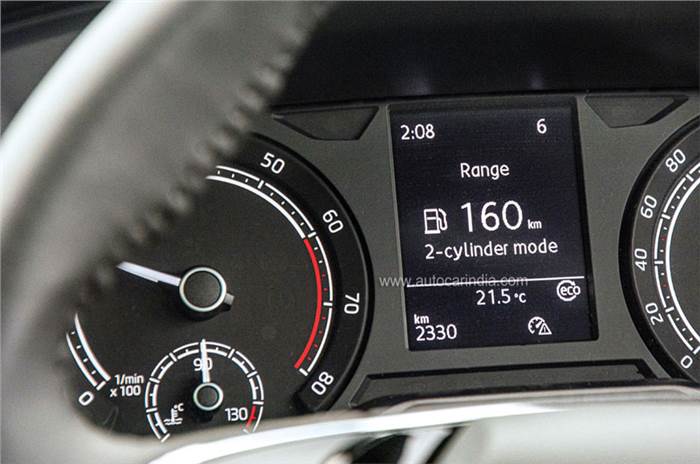Skoda Kushaq review, road test
Does this Creta-rival have what it takes to grab a sizeable share of the midsize SUV pie? We find out.
Published on Oct 03, 2021 09:00:00 AM
1,10,926 Views
Follow us on
While we’ve experienced the 1.0-litre TSI engine in the Skoda Rapid before, in the Kushaq, this engine churns out 115hp and 178Nm, which is 5hp and 3Nm more. Does that result in even stronger performance than its sedan sibling? Being nearly a hundred kilograms heavier than the Rapid, the 1.0-litre TSI doesn’t feel quite as energetic in the Kushaq. There’s adequate performance on tap, as long as the engine is spinning over 1,800rpm, and power delivery is smooth and uninterrupted. This direct injection motor serves peak torque over a broad 2,750rpm band, from 1,750-4,500rpm, so overtaking or closing gaps in traffic is quite easy. Flat-out, it will sprint to 100kph in just 11.47sec, which is very quick, but the gearing could have been a touch shorter for better driveability in the lower gears. The gap between the second and third gear ratio is unusually wide, and during a spirited drive, you’ll often find yourself downshifting to second, rather than staying in third, to make quick progress. As a gearbox, the MQ200 6-speed manual is smooth in its operation, with well-defined gates, but the shifts aren’t quite as smooth as its Korean rivals.

The AQ250 6-speed torque converter paired to the 1.0-litre TSI is an all-new fourth-generation Aisin transmission, making its global debut in the Kushaq. This automatic gearbox is smooth for the most part and works well with this engine. Skoda has intentionally kept the engine idling speed rather high, to prevent it from stalling. As a result, it leaps forward from a standstill rather aggressively, so you need to carefully modulate the brakes to control this behaviour. After the initial lurch, the transmission is programmed to shift to the highest possible ratio at the earliest, in the interest of fuel efficiency, and as a result you’ll need more aggressive throttle inputs than usual to close gaps in traffic. Flat-out acceleration is rather lazy and it sprints from 0-100kph in 13.16sec. To extract the best out of this engine, the automatic gets a ‘Sport’ mode that negates the sluggish engine behaviour by holding gears longer than when in ‘D’. There are paddle shifters, as well as a tiptronic mode, for manual control over the transmission. Downshifts, however, aren’t particularly smooth and the transition from third to second or second to first gear can get quite jerky at times.
The pick of the range is undeniably the EA211 EVO 1.5-litre TSI, four-cylinder, turbo-petrol engine. It feels strong right from the get-go and is eager to make an impression. Unlike its small-capacity sibling, there isn’t any perceptible delay before the turbo starts singing, and from almost idling RPMs, this motor feels energetic. A thick wave of torque is delivered in a clean, uninterrupted serving, and this motor keeps pulling strongly all the way till 6,500rpm in the lower gears. The MQ281 6-speed manual gearbox requires a firm shove to slot into the gates and even the clutch is on the heavier side. So, this isn’t the ideal version for someone whose daily commute involves bumper-to-bumper traffic crawls.

Transmission duties in the automatic are carried out by a 7-speed dual-clutch unit, the newest iteration of the DQ200 family; its predecessor served in the outgoing Polo 1.2 GT TSI and the Skoda Octavia 1.8 TSI. This automatic feels very smooth, and like before, the shifts are lighting quick; downshifts, however, aren’t nearly as quick in full-automatic mode. You will do well by tugging the left paddle a few times to downshift to the right gear when in a hurry. And it is when you take over manual control that you will truly appreciate the quickness with which this transmission performs, adding a greater degree of sportiness to the drive experience. What’s interesting is that both, the manual and automatic accelerate at an identical pace, taking an identical 9.5sec to sprint to 100kph, and going on to hit a top speed of around 190kph.
The 1.5 TSI DSG version is noisier than the 1.5 TSI manual at mid revs, and the engine boom inside the cabin keeps getting louder as the revs climb. Drive the 1.5 TSI and the 1.0 TSI versions back-to-back and this four-cylinder engine’s smoothness certainly impresses. While the 1.0 TSI isn’t what you’d term as gruff or unrefined by any stretch of the imagination, being a three-cylinder, it does emanate a typical thrum at higher revs.
Copyright (c) Autocar India. All rights reserved.






Comments
Member Login
Personal Details
No comments yet. Be the first to comment.